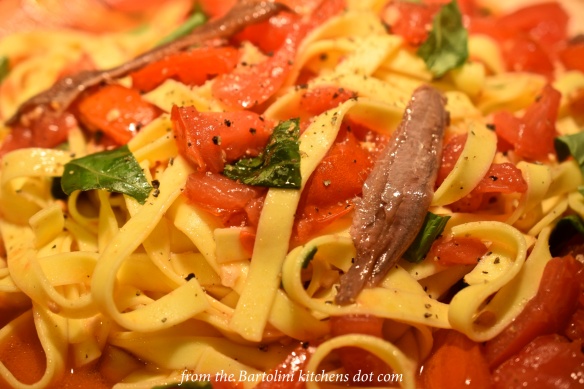Tagliatelle al Pomodoro Crudo
* * *
Yes, I’m back! I hadn’t intended to be away nearly so long but there you have it. I realize that I posted the Greta introduction recently but this post needed to be published ASAP. In this part of the world, the tomato plants have reached peak production. There’s no better time to prepare Insalata Caprese, Panzanella Salad, and Pappa al Pomodoro, as well as today’s pasta, than right now.
Surprisingly, this dish wasn’t served when I was a boy. With Grandpa’s garden easily meeting the tomato needs of both families, it’s a wonder that no one ever used a few of them to make this pasta. I can only say that I’m glad that I came upon the recipe a few years ago and have enjoyed it every August since.
If you google Pasta al Pomodoro Crudo, you’ll find there are many recipes for the dish. In its purest form, all that’s required to prepare the sauce are ripe tomatoes, olive oil, garlic, basil, and salt & pepper, with pasta being the only cooked ingredient. Whether to use grated cheese when served is left up to the cook’s preferences. Some have added capers to the mix, and I myself have added anchovies. There are recipes that include onions that have been rinsed or lightly sautéed before being added to the pasta. Still more will lightly cook the tomatoes before adding the pasta. Of all the versions I’ve tried, the latter using slightly cooked tomatoes is the one I’ve avoided. For me, the taste of fresh tomatoes is what makes this dish so special. Cooking, no matter how slight, would ruin this for me. Nothing compares with the aroma of fresh tomatoes combined with basil and olive oil. When brought to the table, it’s practically intoxicating. Give it a try and I bet you’ll agree. Still not convinced? OK. What do you intend to do with all of those tomatoes you’ve been picking?
This is such a simple recipe. Just be sure to use ripe tomatoes with fresh basil and garlic. This is not the time for canned/jarred/dried ingredients. Once assembled, let the sauce rest for about an hour before cooking the pasta. (See Notes.) Lastly, the ingredient amounts listed below are merely guidelines. you may wish to have more/less tomatoes in your pasta. The same is true for the basil.
* * *
* * *
Pasta with Raw Tomatoes
Ingredients
- 3 to 4 tbsp olive oil
- 2 to 3 very ripe, medium-size tomatoes, seeded and chopped (see Notes)
- hand-torn basil leaves, more for garnish.
- 2 anchovies, minced + more, whole, for garnish (optional)
- 1 clove garlic, grated
- salt and pepper, to taste
- 1/3 lb (150 g) cooked tagliatelle (see Notes)
- grated Pecorino Romano cheese (optional)
Directions
- Seed and chop the tomatoes.
- In a large bowl, place the tomatoes, basil, garlic, anchovies (if using), and olive oil. Gently mix to combine. Cover and set aside.
- After about an hour, bring a large pot of salted water to the boil. Add the pasta and, following package directions, cook until al dente. Drain the pasta, reserving about a cup of the pasta water.
- Add the hot pasta to the raw tomato sauce and gently stir. If overly dry, add some of the reserved pasta water to moisten. (See Notes)
- Move to a serving platter and garnish with more torn basil and, if using, grated cheese and whole anchovies.
* * *
* * *
Notes
You can use any tomatoes for this recipe just so long as they are ripe. I seed “regular” tomatoes but only halve cherry tomatoes when using.
Use any type of pasta you prefer. I like tagliatelle but either penne or farfalle, for example, will work just as well.
My use of anchovies started last year when I had some leftover from preparing pizza the night before. I’ve included the little fishies ever since. No need to use them if you don’t like them.
I’ve never let the sauce sit for hours or overnight because I fear the tomatoes would lose too much of their structure. The firmer the tomato the better, in my book.
If the final dish is too dry, you can also add a drizzle of olive oil with(out) the pasta water to moisten it.
* * *
Coming soon to a monitor near you …
I’m working on it …
* * *
It’s déjà vu all over again …
 We knew summer was in full-swing when platters of Mom’s tomato antipasti appeared on the dinner table. Another easy dish to prepare, these are a wonderful way to serve ripe tomatoes without touching the stove — a blessing on many August days. You can learn how to prepare Mom’s dish HERE.
We knew summer was in full-swing when platters of Mom’s tomato antipasti appeared on the dinner table. Another easy dish to prepare, these are a wonderful way to serve ripe tomatoes without touching the stove — a blessing on many August days. You can learn how to prepare Mom’s dish HERE.
* * *











